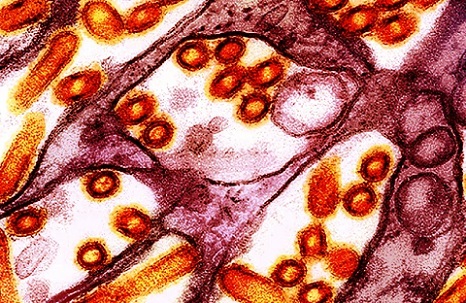U.S. NIH Study Uncovers Why Most Current H5N1 Infections Are Not as Severe as Past Infections
Nikhil Prasad Fact checked by:Thailand Medical News Team Jan 13, 2025 9 months, 3 weeks, 22 hours, 43 minutes ago
Medical News: A Shift in H5N1 Severity
The U.S. National Institutes of Health (NIH) has unveiled findings from a groundbreaking study that sheds light on why the current H5N1 avian flu infections in humans are less severe than those witnessed during earlier outbreaks. This significant discovery comes at a time when concerns over zoonotic diseases are at an all-time high due to the increasing intermingling of animal and human ecosystems.
 U.S. NIH Study Uncovers Why Most Current H5N1 Infections Are Not as Severe as Past Infections
U.S. NIH Study Uncovers Why Most Current H5N1 Infections Are Not as Severe as Past Infections
The research team, comprising experts from the National Institute of Allergy and Infectious Diseases (NIAID), conducted an in-depth analysis of viral behavior and human immune responses. This
Medical News report delves into the study's findings, illustrating how contemporary strains of H5N1 have adapted in ways that mitigate disease severity while emphasizing the need for continued vigilance against potential mutations.
Historical Context: The Deadly Legacy of H5N1
H5N1, a highly pathogenic avian influenza (HPAI) virus, first garnered global attention in 1997 when it caused severe illness and death in humans in Hong Kong. With mortality rates nearing 50% during subsequent outbreaks in the early 2000s, the virus earned a reputation as one of the deadliest zoonotic threats.
However, recent infections, particularly those associated with the H5N1 clade 2.3.4.4b virus, have presented milder symptoms, prompting researchers to investigate the underlying mechanisms of this shift.
The Study: Decoding the Contemporary H5N1 Virus
The study utilized advanced human lung organoids (hLOs) derived from adult stem cells and induced pluripotent stem cells to mimic the human alveolar epithelium. These models allowed researchers to compare the replication efficiency, immune response, and cell survival rates of historic and contemporary H5N1 isolates.
The isolates examined included:
-A historic human isolate from 2004 (A/Vietnam/1203/2004), known for causing severe respiratory illness and high mortality.
-A 2024 cattle-derived isolate (A/bovine/Ohio/B24OSU-342/2024).
-A 2024 human-derived isolate (A/Texas/37/2024) linked to a dairy farm worker in Texas.
Key Findings
-Viral Replication Efficiency
The historic H5N1 isolate demonstrated significantly higher replication efficiency in both types of lung organoids compared to the contemporary isolates. Among the recent strains, the human-derived Texas isolate showed greater replication fitness than the cattle-derived isolate. This variance was attributed to the presence of the PB2 E627K mutation in the Texas isolate, which enhances replication in mammalian hosts.
-Cell Death Patterns
The study observed earlier and more extensive cell death in organoids infected with the historic isolate. In
contrast, the contemporary strains induced cell death at a slower rate, with all three isolates showing comparable levels of cell death by 96 hours post-infection. This suggests that factors beyond direct viral cytotoxicity play a role in disease severity.
-Immune Response Modulation
Historic isolates elicited a robust activation of interferon-stimulated genes (ISGs) and proinflammatory cytokines, particularly in adult stem cell-derived hLOs. This heightened immune response is consistent with the severe inflammation and cytokine storms observed in past H5N1 cases. Conversely, contemporary isolates demonstrated a capacity to suppress ISG responses, thereby evading the human interferon system. This adaptation likely contributes to the milder symptoms associated with current infections.
Implications for Public Health
The reduced severity of recent H5N1 infections offers a glimmer of hope, but it should not lead to complacency. The virus’s ability to adapt and suppress human immune responses could mask its potential for further evolution. Enhanced surveillance of H5N1 clade 2.3.4.4b viruses is critical, particularly given their unusual ability to infect mammals, including cattle.
Broader Trends: The Growing Host Range of H5N1
Since 2021, H5N1 clade 2.3.4.4b has been circulating extensively in avian populations across North America. In 2024, it was detected in cattle, spreading across 16 U.S. states. The virus’s unprecedented host range raises concerns about its spillover into humans. To date, 66 human cases have been confirmed in the U.S., with most linked to direct contact with infected cattle or poultry. Symptoms have predominantly been mild, with only one reported fatality.
Conclusions
This study underscores the importance of continued research into the molecular mechanisms underlying H5N1 pathogenicity. While contemporary strains appear to cause less severe disease, their ability to evade the human immune response poses a latent risk. Should the virus acquire additional mutations that enhance its transmissibility or virulence, the consequences could be dire.
Moreover, the findings emphasize the value of using cutting-edge organoid models to study human-specific responses to emerging pathogens. By revealing the interplay between viral evolution and host immunity, this research lays the groundwork for more targeted surveillance and intervention strategies.
Final Thoughts
As H5N1 continues to evolve, the global health community must remain vigilant. The current era of milder infections could shift rapidly if new mutations emerge. Strengthened biosecurity measures, robust surveillance programs, and ongoing research are essential to mitigate the threat posed by this enigmatic virus.
The study findings were published in the peer-reviewed journal: Emerging Infectious Diseases.
https://wwwnc.cdc.gov/eid/article/31/2/24-1147_article
For the latest H5N1 News, keep on logging to Thailand
Medical News.
Read Also:
https://www.thailandmedical.news/news/german-scientists-warn-that-h5n1-is-mutating-to-develop-resistance-to-a-human-protein-viral-suppressor-called-mxa
https://www.thailandmedical.news/news/cambodian-man-succumbs-to-h5n1-bird-flu-after-consuming-infected-chicken
https://www.thailandmedical.news/articles/h5n1-avian-flu
